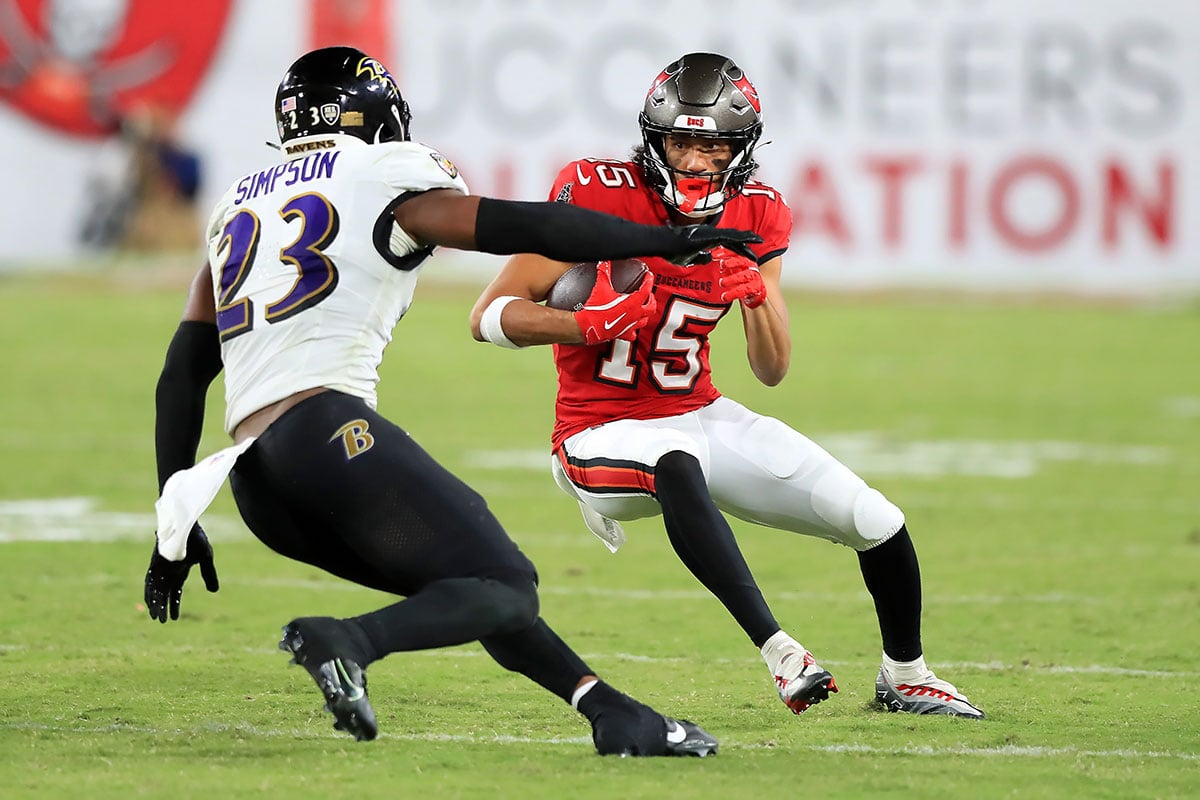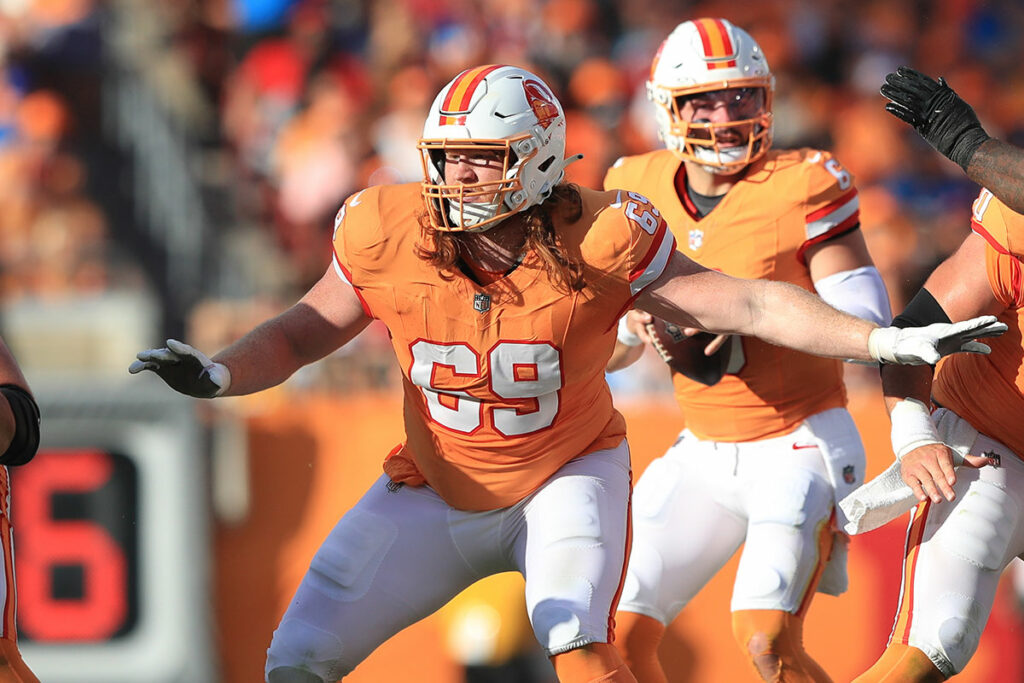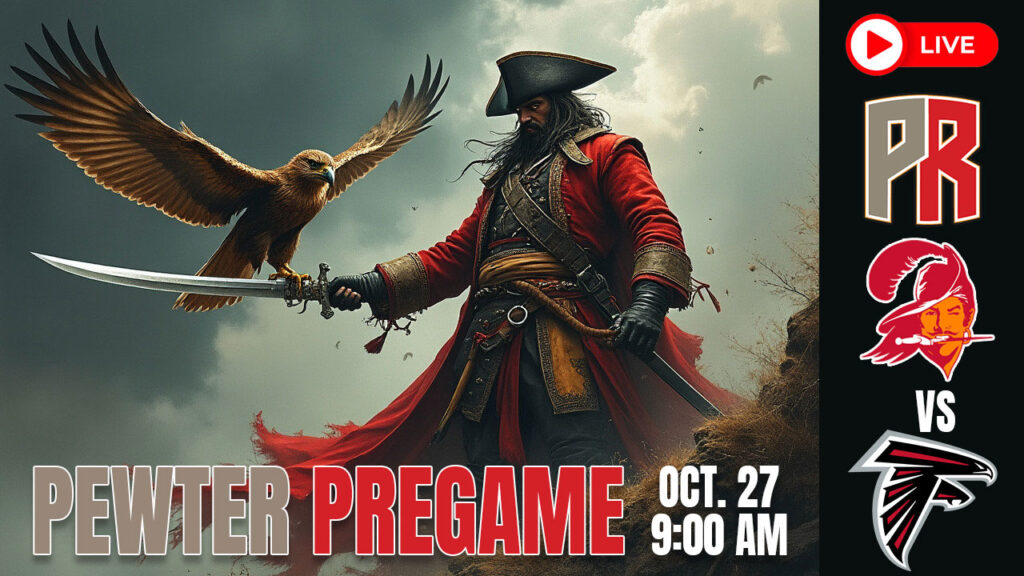Bucs starting receivers Mike Evans and Chris Godwin are out for the foreseeable future. Godwin is gone for the season and Evans is most likely out through the team’s Week 11 bye. In their stead, the Bucs will have to rely on young receivers Trey Palmer and Jalen McMillan, along with veteran Sterling Shepard and tight end Cade Otton.
While this group is unlikely to replicate the star power of Evans and Godwin, each has a skillset that, if harnessed, can still help the Bucs offense stay on time and be effective enough to keep the boat afloat until Evans’ return.
Positional Usage
The Bucs offense uses three receiver designations within the offense. “X”, “Z” and “F”. The “X” receiver spot was previously occupied by Evans. That receiver is typically isolated in 3×1 sets, lined up on the line of scrimmage and tasked with trying to beat press coverage.
Trey Palmer is the most likely candidate to move into that position until Evans returns due to his deep speed that can help stretch the field and requires attention from top-down safeties.
The “F” receiver typically lines up in the slot and is asked to run a lot of choice routes where his route is dependent upon the coverage and leverage in front of him. He and the quarterback have to be extremely in tune with each other to see and understand the defense the same way and make the same decision as far as how his route should develop. Here are three examples of that choice route from Chris Godwin, who played the “F” role previously.
Big part of Liam Coen’s offense is the choice route. They have used it a good bit on 3rd and medium to great success with Godwin. It is one area I am expecting Jalen McMillan to pick up a good portion of the slack, but it will require him and Baker to read things out the same. pic.twitter.com/NRB8x9PPpC
— Joshua Queipo (@josh_queipo) October 26, 2024
As noted in the post above, McMillan should serve in that role going forward because he is a natural separator who can find holes in the zone. That leaves Shepard to play the “Z” as an outside receiver who plays off the line and is less likely to take on jams from cornerbacks and more likely to motion pre-snap like the “F.”
I wanted to look at each receiver, plus Otton, by their route distribution to this point to see where the Bucs may excel and where there may be some gaps as offensive coordinator Liam Coen looks to create points without his two best playmakers. I parsed through route data from SIS for the last two years for Otton and Palmer and just this season for McMillan and Shepard.
Best Routes By Bucs Receivers
Jalen McMillan
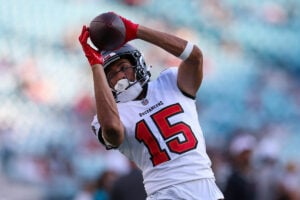
Bucs WR Jalen McMillan – Photo by: USA Today
McMillan draws the most interest as a third-round pick with a ton of hype in training camp and preseason. Known as a natural separator, he flashed his ability to get open even into the first few games of the season. However, he has struggled with catching the football early in his career and will face the most difficulties in filling Godwin’s role because he has yet to prove he can be trusted in traffic.
I agree with JT’s assessment of JMac’s strength.
BUT a big part of what makes Chris, Chris is the ability to catch the ball.
Career 74% catch rate (83% this year!). Career 60% Contested catch rate.
McMillan 40% catch rate, 0-5 contested.
67% in college and 20% contested. https://t.co/nTDeOfGRVm— Joshua Queipo (@josh_queipo) October 24, 2024
McMillan’s Best Route – Corner Route (10% of routes run, 32 yards per catch, 1.32 EPA/target)
McMillan on the Corner Route pic.twitter.com/T1XSgqF4cN
— Joshua Queipo (@josh_queipo) October 26, 2024
McMillan can create easy speed and find holes in zone coverage. In college and to start his NFL career, he has been looked to as an intermediate-to-deep option with an average depth of target of 14.1. The Bucs will change much of what McMillan has been asked to do as he moves into that “F” receiver role.
Godwin’s adot (average depth of target) this year was a career-low 5.6. On targets of 10 yards or less, McMillan has caught four of his six targets on the year for 21 yards. It has not been his strongest suit thus far.
I worry about McMillan in this role the most because the position is so critical to the offense and requires a sure-handed, tough receiver who can win close to the line of scrimmage in heavy traffic and then create after the catch. My draft eval of McMillan was that he wins downfield late on routes but was not a sure-handed receiver or much of a creator after the catch. This will be a true test for him.
Trey Palmer

Bucs WR Trey Palmer – Photo by: Cliff Welch/PR
Palmer will move into Evans’ “X” receiver role. In the Bucs offense, it isn’t a volume position but is essential to creating downfield stretch on the defense and can add vertical explosiveness.
Palmer’s Best Route – Post (8% of routes run, 18.5 yards per catch, 0.71 EPA/target)
Great throw and catch. pic.twitter.com/orBojyzxsb
— Joshua Queipo (@josh_queipo) October 27, 2024
I am excited to see what Palmer can do in this role because his best routes are deep developing and leverage his elite 4.33 speed. In addition to posts, Palmer has had success on digs, curls and out routes. These are routes that Evans has done well on over the course of his career.
Sterling Shepard
Shepard should slide into the “Z” role that he and McMillan have been splitting up until this point. Shepard is a dynamic route runner who lacks the size to play the “F” role, working in towards the line of scrimmage on inset blocks.
Shepard’s Best Route – Out (7% of routes run, 10.4 yards per catch, 0.62 EPA/target)
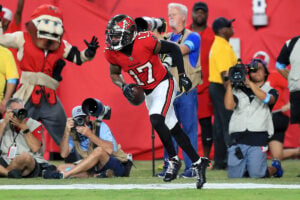
Bucs WR Sterling Shepard – Photo by: Cliff Welch/PR
Shep on the quick out pic.twitter.com/tOOTplutmM
— Joshua Queipo (@josh_queipo) October 27, 2024
Shepard is a sharp route runner who can break quickly in and out of his cuts. Speed outs are a great way to steal yards on early downs and they are a favorite of quarterback Baker Mayfield. But he is also the most versatile piece in the room. He still has a fantastic ability to decelerate, manipulate leverage and coverage.
Don’t be surprised if he is the receiver getting the most looks in “have to have it” situations. He has a proven track record of getting open with a career catch rate of 67%. But Shepard has usually been a short-to-intermediate threat more so than a deeper one. If not for his stature, he and McMillan would be better served reversing their roles.
Cade Otton
I’ll admit that coming into this season, I was fairly down on Otton. I thought he was an adequate, low-end starting tight end. But I was not of the opinion the Bucs needed to spend resources to make an upgrade over him, as the tight end position has rarely been a focal point of the type of offense Coen runs. But I want to give Otton a ton of credit.
He has legitimately improved here in his third season in the NFL. He has developed into a much better run blocker, and he has improved as a receiver as well. Otton’s drop rate has been cut in half this year and his yards per route run is at a career high. He is also coming off of the best game of his career as he made difficult catch after difficult catch late in the Ravens game, leading to the highest receiving yardage game of his career.
Otton’s Best Route – Seam (9% of routes run, 20.6 yards per catch, 0.34 EPA/target)

Bucs TE Cade Otton – Photo by: USA Today
From last year, but one of Cade Otton’s more underrated skills is how good he can be making tough catches running seam routes. pic.twitter.com/2ywTSHtzKt
— Joshua Queipo (@josh_queipo) October 27, 2024
Otton hasn’t been asked to run many seams this year. It was more a staple of former offensive coordinator Dave Canales’ system. But he was very successful on those routes. As Coen has to adjust his offense without Evans and Godwin, asking Otton to run more seams could help open up the underneath for McMillan and Shepard to operate.
And without Evans, Coen will need to get creative in how he forces safeties to respect the vertical element of the offense more than just sending Palmer.
But Otton can, and should, be more than just a seam runner. He and quarterback Baker Mayfield have a good rapport on out quick outs and flat routes where Otton can often create after the catch. He has also proven to be a positive running a variety of routes including curls, drags and slants. And Otton is a good screen receiver. Both Coen and Canales have leaned into that part of Otton’s game in the last two years.
The Bucs offense can still be effective even if it is likely to take a step back. The important thing for Liam Coen is to adjust to his current talent’s best traits to find a blend that works. Mayfield’s best stuff is a known quantity. Outside breaking routes with a lean to the right side of the field. Flood is his favorite concept. This current crop can run Flood well.
Palmer has the speed to run the deep go/corner, and McMillan, Shepard and Otton can interchange on the intermediate out. And each receiver has enough individuality to how they win to allow for adaptability in the offense to still generate yards, drives and points until Evans can come back.
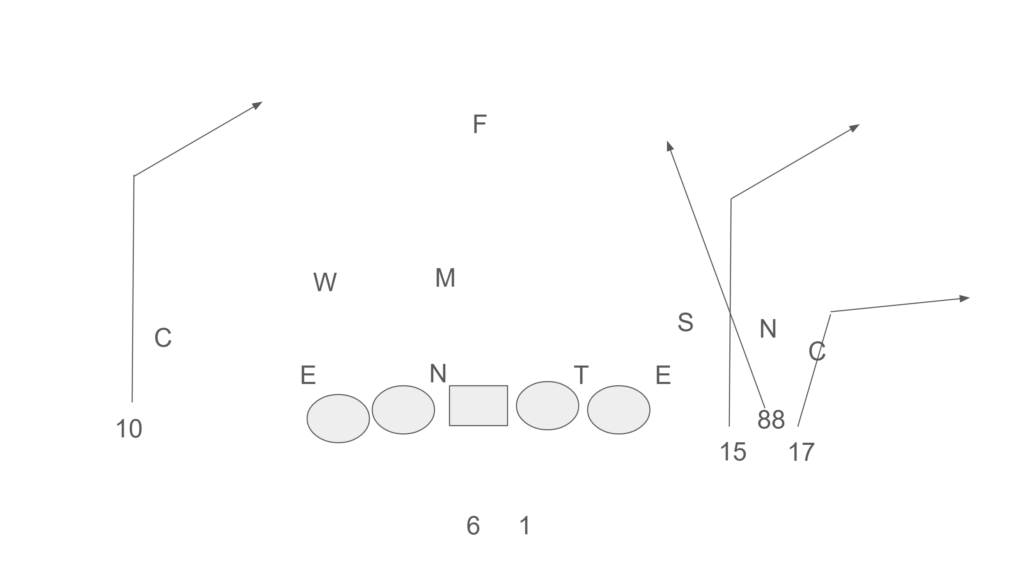
It won’t be easy. But it’s also not an impossible task.
Josh Queipo joined the Pewter Report team in 2022, specializing in salary cap analysis and film study. In addition to his official role with the website and podcast, he has an unofficial role as the Pewter Report team’s beaming light of positivity and jokes. A staunch proponent of the forward pass, he is a father to two amazing children and loves sushi, brisket, steak and bacon, though the order changes depending on the day. He graduated from the University of South Florida in 2008 with a degree in finance.

